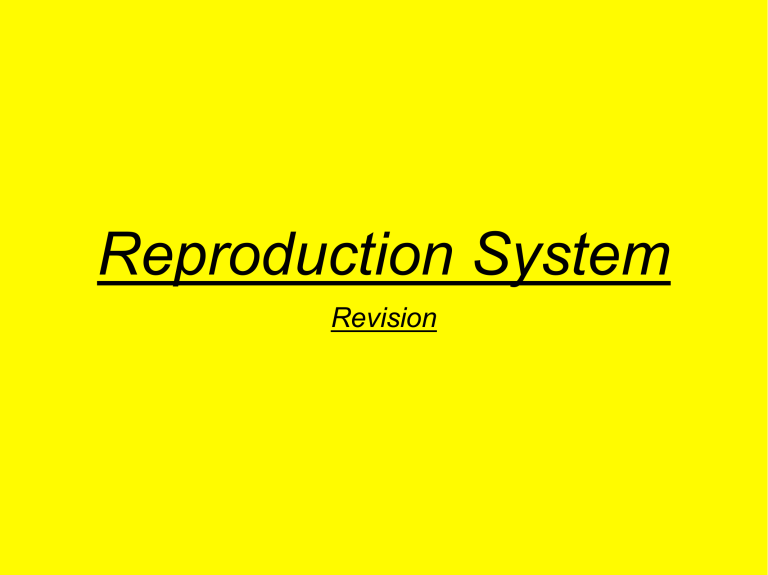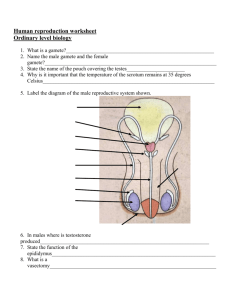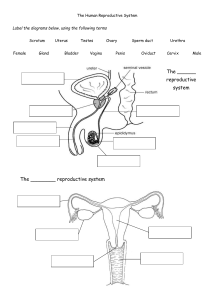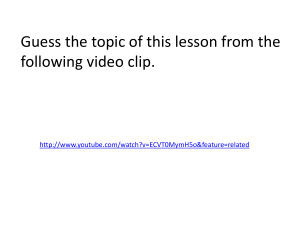
Reproduction System Revision The male reproductive system The human male reproductive system contains these parts: - Glands Sperm ducts Urethra Penis Testes *The parts of the human male reproductive system. The bladder empties into the urethra but is not part of the reproductive system. Testes The two testes (one of them is called a testis) are contained in a bag of skin called the scrotum. The testes have two functions: - to produce millions of male gametes (sex cells) called sperm. - to make male sex hormones, which affect the way a man's body develops Sperm Ducts and Glands The sperm pass through the sperm ducts, and mix with fluids produced by the glands. The fluids provide the sperm cells with nutrients. The mixture of sperm and fluids is called semen. Penis and Urethra The penis has two functions: - To pass urine out of the man’s body - To pass semen out of the man’s body The urethra is the tube inside the penis that can carry urine or semen. A ring of muscle makes sure that there is no chance of urine and semen getting mixed up. The female reproductive system The human female reproductive system contains these parts: - Oviducts Ovaries Uterus Cervix Vagina *The parts of the human female reproductive system. The bladder empties into the urethra but is not part of the reproductive system. Ovaries and Oviducts - The two ovaries (one of them is called an ovary) contain hundreds of undeveloped female gametes (sex cells). These are called ova (one of them is called an ovum) or egg cells. Women have these cells in their bodies from birth, whereas men produce new sperm continually. - Each ovary is connected to the uterus by an oviduct. This is sometimes called a Fallopian tube or egg tube. The oviduct is lined with cilia, which are tiny hairs on cells. Every month, an egg develops, becomes mature and is released from an ovary. The cilia waft the egg along inside the oviduct and into the uterus. Uterus and Cervix - The uterus, also called the womb, is a muscular bag with a soft lining. The uterus is where a baby develops until its birth. -The cervix is a ring of muscle at the lower end of the uterus. It keeps the baby in place while the woman is pregnant. Vagina - The vagina is a muscular tube that leads from the cervix to the outside of the woman's body. A man's penis goes into the woman's vagina during sexual intercourse. The Menstrual Cycle - The female reproductive system includes a cycle of events called the menstrual cycle. It lasts about 28 days, but it can be slightly less or more than this. The cycle stops while a woman is pregnant. These are the main features of the menstrual cycle: The start of the cycle, day 1, is when bleeding from the vagina begins. This is caused by the loss of the lining of the uterus, with a little blood. This is called menstruation or having a period. - By the end of about day 5, the loss of blood stops. The lining of the uterus begins to re-grow and an egg cell starts to mature in one of the ovaries. The Menstrual Cycle At about day 14, the mature egg cell is released from the ovary. This is called ovulation. The egg cell travels through the oviduct towards the uterus. - If the egg cell does not meet with a sperm cell in the oviduct, the lining of the uterus begins to break down and the cycle repeats. The Menstrual Cycle *The thickness of the uterus lining varies during the menstrual cycle. An egg is released at about day 14 - Fertilisation happens if the egg cell meets and joins with a sperm cell in the oviduct. The fertilised egg attaches to the lining of the uterus. The woman becomes pregnant, the lining of the uterus does not break down and menstruation does not happen. Gametes and Fertilisation Humans typically reproduce through sexual reproduction. Sexual reproduction produces offspring that are unique individuals. Half of their genes come from each parent. Gametes Gametes are the sex cells: - Eggs are female gametes - Sperm are male gametes Gametes and Fertilisation Gametes have adaptations to increase the chances of fertilisation and successful development of an embryo. For example, sperm cells are produced in large numbers to increase the chance of fertilisation. Sperm cells have these adaptations: -a tail to move them towards an egg cell -Many mitochondria to provide energy -An acrosome (part of tip of the head) that releases enzymes to digest the egg membrane Gametes and Fertilisation Fertilisation - In sexual reproduction, a male gamete and a female gamete join together. This is fertilisation. Fetal development and Birth Fetal development - Fertilisation happens when an egg cell meets with a sperm cell and joins with it. The fertilised egg divides to form a ball of cells called an embryo. The embryo attaches to the lining of the uterus. It begins to develop into a fetus and finally into a baby. Fetal development and Birth Development of the Fetus The fetus relies upon its mother as it develops. These are some of the things it needs: - Protection against knock and bumps, and temperature changes - Oxygen for respiration - Nutrients (food and water) The developing fetus also needs its waste substances removing. A fetus develops in the uterus into a baby ready to be born. The fetus is protected by the uterus and the amniotic fluid, a liquid contained in a bag called the amnion. Fetal development and Birth The Placenta The placenta is an organ responsible for providing oxygen and nutrients, and removing waste substances. It grows into the wall of the uterus and is joined to the fetus by the umbilical cord. The mother's blood does not mix with the blood of the fetus, but the placenta lets substances pass between the two blood supplies: - oxygen and nutrients diffuse across the placenta from the mother to the fetus - carbon dioxide and other waste substances diffuse across the placenta from the fetus to the mother Fetal development and Birth - The mother’s lifestyle can affect the developing fetus. For example, smoking reduces the amount of oxygen in the bloodstream. This can lead to low birth weight and premature birth (when a baby is born too soon). Drinking alcohol during pregnancy can harm the developing baby’s nervous system, especially its brain. The blood of the mother and fetus do not mix, but substances diffuse across the placenta Fetal development and Birth - The mother’s lifestyle can affect the developing fetus. For example, smoking reduces the amount of oxygen in the bloodstream. This can lead to low birth weight and premature birth (when a baby is born too soon). Drinking alcohol during pregnancy can harm the developing baby’s nervous system, especially its brain. The blood of the mother and fetus do not mix, but substances diffuse across the placenta








